Survey of London: Volume 15, All Hallows, Barking-By-The-Tower, Pt II. Originally published by London County Council, London, 1934.
This free content was digitised by double rekeying. All rights reserved.
'Custom House Quay and the Old Custom House', in Survey of London: Volume 15, All Hallows, Barking-By-The-Tower, Pt II, ed. G H Gater, Walter H Godfrey (London, 1934), British History Online https://prod.british-history.ac.uk/survey-london/vol15/pt2/pp31-43 [accessed 11 May 2025].
'Custom House Quay and the Old Custom House', in Survey of London: Volume 15, All Hallows, Barking-By-The-Tower, Pt II. Edited by G H Gater, Walter H Godfrey (London, 1934), British History Online, accessed May 11, 2025, https://prod.british-history.ac.uk/survey-london/vol15/pt2/pp31-43.
"Custom House Quay and the Old Custom House". Survey of London: Volume 15, All Hallows, Barking-By-The-Tower, Pt II. Ed. G H Gater, Walter H Godfrey (London, 1934), British History Online. Web. 11 May 2025. https://prod.british-history.ac.uk/survey-london/vol15/pt2/pp31-43.
IX.—CUSTOM HOUSE QUAY AND THE OLD CUSTOM HOUSE
Until the year 1814 the Custom House stood in the parish of All Hallows Barking, and Custom House Quay, which occupied its south-western corner, is for that reason the most important and certainly the most historic of all the quays in the parish. The present Custom House is situated in the parish of St. Dunstan in the East, immediately to the west of the old site, which is now in the occupation of the well-known shipping firm of Muller.
In the early Plantagenet period the Customs Revenue was derived from the Great Custom on exported Wool, the Tunnage on Wine and the Poundage on other goods, and in very early days it was for the purpose of the first-named revenue only that the buildings on this site were used. Hence we find that for many centuries it bore the name of Wool Quay. The present site has a river frontage of approximately 240 feet, and a depth through to Lower Thames Street of just over 160 feet. It embraces three original quays, formerly known as Hartshorn Quay, Old Wool Quay and New Wool Quay.
The Old Wool Quay is that with which the Customs Revenue has the longest connection. Its name indicates that it was the quay on which the wool about to be exported was weighed for Customs purposes, and the King's Troneur or weigher, the equivalent of the Customs Officer of the present day, would necessarily have some sort of office or Custom House on the quay. Old Wool Quay can be traced back well into the 13th century, and probably at least to the third year of Edward I (1275), when the revenue of the King was reformed and put on a settled basis.
The Old Wool Quay, notwithstanding its connection with the Customs Revenue, remained in private hands down to the year 1721, and would seem to have changed ownership very frequently.
In the year 1310 we find a precept issued to the Sheriffs to take into the City's hands the lands and tenements of Hugh Baudry and Agnes his wife, and to certify their value. These lands included the Old Wool Quay. Hugh died, and Peter de Blount married his widow and continued living in the house, but the wharf would seem to have been let by them to Roger de Romsey. (fn. 1)
The story is not quite continuous, and probably some documents are missing from the record, for the next tenancy is without any explanation of change. It is a note in the Hustings Rolls that William de Bodele bequeaths to Sarah, his wife, tenements and wharf at "le Wollewharf." (fn. 2)
This transaction no doubt refers to some lease or lien on the property, since, seven years later, we find a Hustings Roll in which Godwyn Turk makes over to his wife Petronella for life all his tenements of which he and she were jointly enfeoffed. "Whereupon [1333] came Petronella and put her claim upon a devise of a certain tenement, wharf, etc., which she and testator had acquired from John, son of Hugh Baudry, whereof she produced proof, and accordingly her challenge was maintained as to the said tenement etc." (fn. 3)
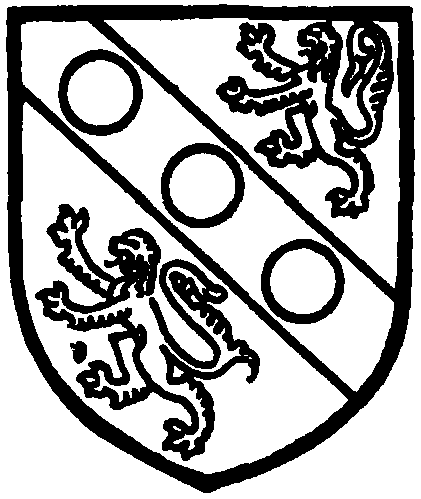
Turk.
Godwyn Turk appears later (fn. 4) in 11 Edward III as a citizen and fishmonger with property in St. Dunstan's parish.
In the following year (1339) we find that Petronella Turk had leased the wharf, now called Baudrie's Wharf, to William de Briklesworth, for in that year the section of the river bank from the Lion Tower to the Stonewharf next to the Wool Quay was ordered to be fortified by the building of battlements and driving of piles. Briklesworth complained that his over-landlord, Petronella Turk, refused to carry out the work, whereupon he was ordered to do it himself and Petronella was ordered to extend his lease to repay the expense. He therefore paid John Tottenham £10 6s. to erect the battlements. (fn. 5)
Petronella Turk seems to have been a wealthy woman. She died in 1350 and was buried in All Hallows Barking church. She left to her sons Robert and Richard a tenement and shops, together with brewing utensils, in Thames Street near "le Wollewharf," paying 12d. to St. Mary Spital, as well as a brewery in Mark Lane charged with the maintenance of her chantry in Spital church; and to her son Andrew a house in Thames Street in the parish of St. Dunstan's. (fn. 6)
Beyond certain references to officials, the next few years pass in silence. There is an order in 1341 to the King's Sergeant-at-Arms to arrest wool in the City of London belonging to the German merchants, (fn. 7) and in 1366 we find a patent appointing William de Loght Controller of the Customs on Wool, Hides and Wool-fells, "taking in the office as other Controllers have taken; so that he write his rolls with his own hand, stay there continually and discharge the office in person and not by substitute. The King wills that one part of the Coket Seal in the said Port remain in his keeping while he hold the office." (fn. 8)
Four years later the controllership was transferred to William de Leek on the same terms, (fn. 9) and again four years later we come to what is perhaps the most interesting of these appointments. This was a patent of 8th June, 1374, issued at Westminster, granting, during pleasure, to Geoffrey Chaucer the offices of Controller of the Customs and Subsidy of Wools, Hides and Wool-fells, and Controller of the Petty Custom of Wines, and of 3d. of the pound also of cloths and other customable merchandise in the Port of London. (fn. 10)
The Petty Customs seems to have been transferred to another controller in the following year, but Chaucer retained the Great Custom on Wool, for in 1377 we find that on account of his being employed by the King "in remote parts" he was allowed to employ a deputy. (fn. 11)
It has been generally stated that the first Custom House was that erected by John Churchman in or about 1382, but the fact that an earlier one was in existence is definitely proved by a patent, dated 31st October, 1377, which is a grant during pleasure to Richard Baret of "the Office of the custody of the house appertaining to the Great Custom upon 'le Wollekey,' London." (fn. 12)
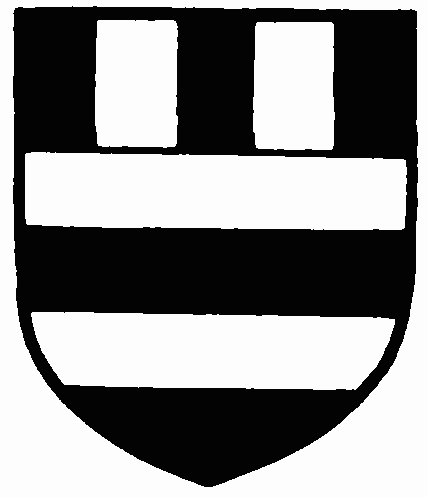
Churchman.
On 12th April, 1378, John Churchman and Emma his wife were granted by Gilbert de Meldeborn and William Rykyl the quay called "le Wollewharf," which quay is described as situated between the quay of the late Thomas de Salisbury, Kt., called "le Stonewharf" on the east and the lane called the "Watergate" towards the west. (fn. 13)
In the following year we find recorded a quit-claim by Thomas Turk, apparently grandson of Godwyn Turk, resigning any claim he might have to the Wool Quay. (fn. 14)
Within the next two or three years John Churchman seems to have pulled down the old buildings on the site and to have erected a new officebuilding for the weighing of wool, his intention apparently being to erect it for the weighing of wool solely in connection with the City dues, for which he was appointed weigher for life. This office on his death was made over to the Grocers' Company, with whom it remained until the eighteenth century.
In 1382 the Government decided that it was unnecessary to have a duplicate procedure of weighing, and accordingly we find a patent granted at Westminster of which the following is a translation:
Indenture witnessing that whereas John Churchman, citizen of London, has newly built for the quiet of Merchants a house on his quay called "le Wollewharf" in Tower Ward in the parish of All Saints Barkyngchirche, London, between the quay of Paul Salesbury on the east and a lane called "le Watergate" on the west, to serve for the tronage of wools in the Port of London, the King has granted that during the life of John, the Tronage shall be held during pleasure in that house and the King shall have easement therein for balances [and] weights and a compter (computatorium) for comptrollers, clerks and other officers of the Tronage, with free ingress and egress, and shall pay the said John 40s. yearly for the same. (fn. 15)
Owing to this change in his plans Churchman was compelled to enlarge the building, and in the following year (1383) we find a further patent, dated 18th July, allowing an additional 40s. rent for the improved accommodation:
Grant for life to John Churchman, citizen of London, of 40s. yearly in addition to the 40s. granted to him by an indenture under the Great Seal dated 4th July, 6 Richard II, for providing a building on the quay called "le Wollewharf" in Tower Ward in the Parish of All Hallows Berkyngchirche, between the quay of Paul Salesbury on the east and the lane called "le Watergate" on the west, for the Tronage of Wools in London, because he has added a small chamber for a latrine and a sollar over the counting house 38 feet long by 21½ feet broad, containing two chambers and a garret, as a further easement for the customers, controllers and clerks. (fn. 16)
Three years later, by a patent dated at Sheen 24th September, 1386, we find a similar grant to John Churchman, ordering that the Petty Custom or Tonnage and Poundage should also be collected and accounted for at Wool Quay. (fn. 17) Accordingly, from that date onwards and for more than four hundred years, this historic site was occupied by the Custom House. On its becoming too small, steps were in 1811 taken to erect the present building on the adjoining site further west, next door to Billingsgate, on the very spot where in a.d. 979 King Ethelred at his Witenagemot at Wantage had ordained the collection of the first Customs of which we have any record. (fn. 18)
Churchman's Custom House lasted for a hundred and eighty years until 1559. The freehold seems to have passed through a variety of hands. In 1392 Churchman conveyed it to a whole body of people who may have been representatives of the Grocers' Company. (fn. 19) One of these was John Shadworth, and in 1399 and again in 1402 we find Letters Patent granting to him the same privilege of having the Custom House in his building at the same rent as had been paid to John Churchman. (fn. 20)
In 1423 the wharf was in the apparent ownership of William Lynne, grocer, for in the Hustings Rolls there is a note of his will by which he bequeaths it to his wife Alice, while his other property was devised to his various children. (fn. 21) The will was made two years before, and is dated 6th August, 1421.
There were three Crown officers in the Custom House at this date: John Botteler and John Norton, collectors, and John Prosfen, controller, and besides these there were the officials appointed by the Customer or Farmer of the Customs, who were his servants and not under the direction of the Crown. (fn. 22)
From this date for a considerable period the history of the quay and Custom House building is somewhat indeterminate. The next item we have to record is an Inquisitio Post Mortem in 1489, which states that Joan, wife of John Stanford … was seized of the sixth part of the sixteenth part of a tenement called "le Olde Wolkey" situated in the parish of " St. Mary [sic] of Barkyng," held in free burgage, worth 26s. 8d., her heir being Thomas Leventhorp. (fn. 23)
Three years later the wharf would seem to have returned to single ownership as it was devised in his mother's will to Christopher Rawson, mercer and merchant of the Staple at Calais. His will is dated 30th September, 1518. In it he leaves his wharf and houses called "The Old Wolle Key," in the parish of All Hallows Barking, in trust for John, Thomas and Richard his sons and the heirs male of their bodies, remainder in trust for Margaret and Katherine his daughters and the heirs male of their bodies; remainder in trust for John and Walter, sons of Nicholas Rawson, his brother in succession, tail male; remainder in trust for Avery Rawson, his brother, remainder over. (fn. 24) There is a fine brass to him and two wives in All Hallows Church. (See p. 68.)
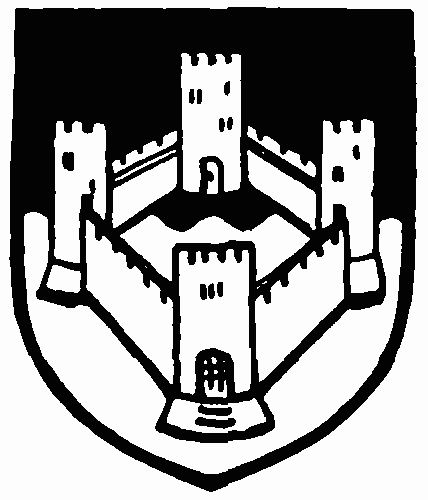
Rawson.
Notwithstanding the comprehensiveness of this will, with its elaborate provisions for remainders, the quay would seem again to have changed ownership within not very many years, when it was acquired by Nicholas Gibson, who died in 1540. In 1552 we have a very interesting will in which again the property is disposed of, and this time in a more permanent manner. It is the will of John Charley, cooper, of London, dated 21st March, 1552, in which he leaves to the Master and Wardens or Keepers of the Commonalty of the Freemen of the "Mistery of Cowpers" of London and of the Suburbs of the same a messuage and wharf called "The Old Wolle Key" in the parish of All Saints Barking, which he held in trust for fulfilment of the will of Nicholas Gibson, late grocer, of London, "according to the laudable customs of the Citie of London to be held by the said Master and Wardens, charged with the maintenance of a mete and learned man in the letters of Grammar to teach Grammar and the knowledge of Grammar and also to instruct little children in the A.B.C. and such learning as should be most convenient in the school or school-house erected at Ratclyffe, co. Middlesex by the aforesaid Nicholas, and also with the maintenance of a Master learned in Latin and Grammar and subject to other conditions as set out in a certain copy of Court Roll of the Manor of Stebbenheith [Stepney], the tenements to be surveyed twice a year and at each survey the Master, Warden, etc., are to have a potacioun among the men of the Mistery." (fn. 25)
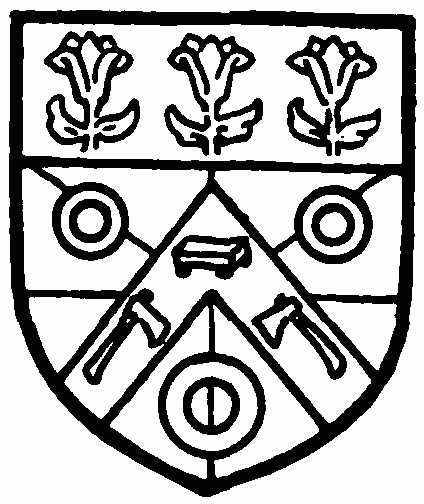
Coppers' Company.
During the whole of this period the Custom House originally erected by John Churchman seems to have been in active use, though there is some evidence that from time to time it had been enlarged. In the well-known panorama of London by Visscher (1616), it is shown as a long building facing the river, with two subsidiary portions on the west end, set at right angles to the main building. In 1559 it was superseded by a new Custom House, ercted under the immediate direction of William paulet, Marquees of Winchester, Lord High Treasurer. (fn. 26)
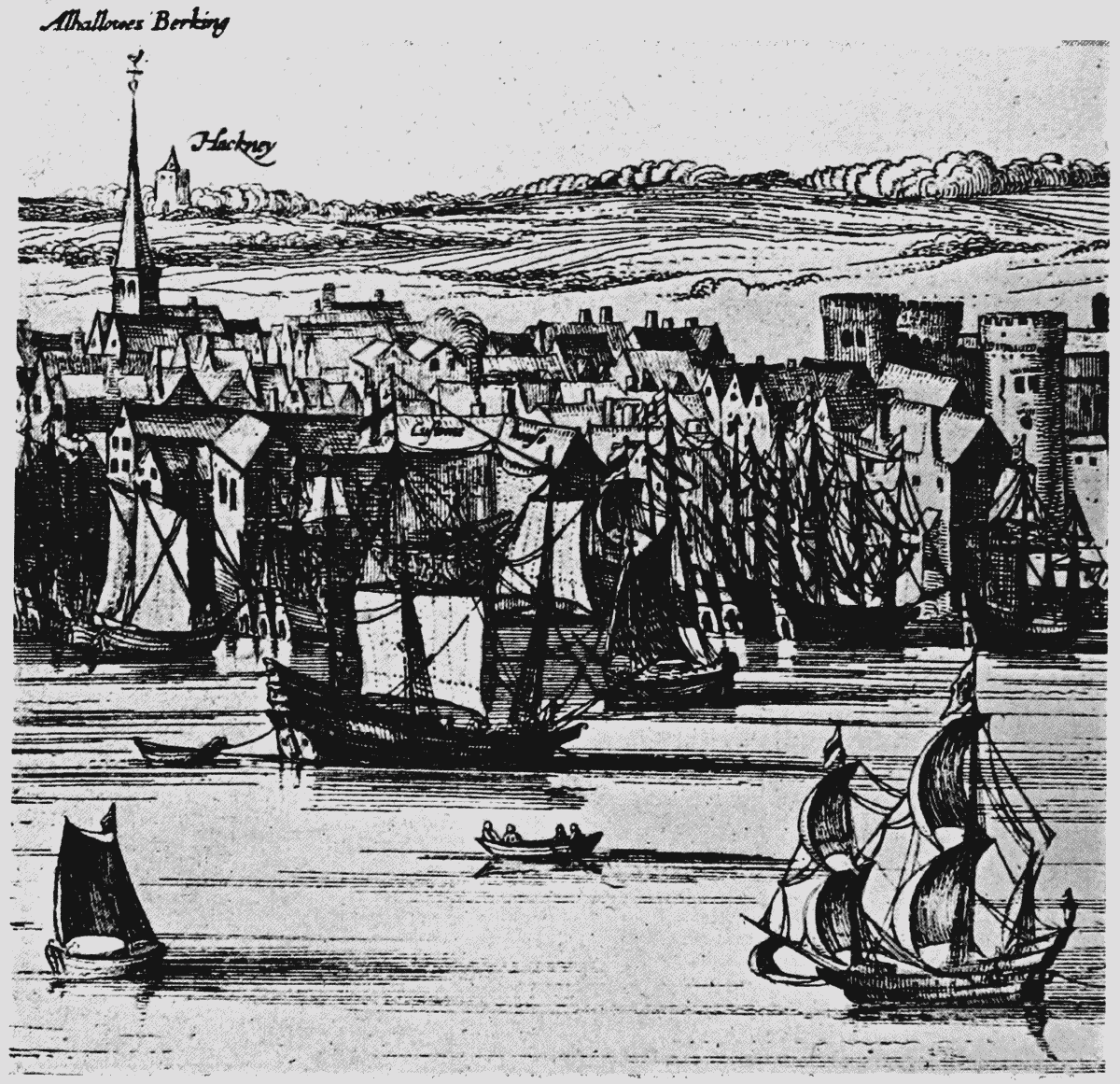
Custom House (Visscher)
Of this building we know but little. A view "Engraved from a scarce print by Bartholomew Howlett," dated 1663 (Plate 63), shows a three-storey brick building, with octagonal staircase towers at the angles and a central one dividing the south front into two sections, the eastern of which is pierced by an archway. In front of it is an extensive open wharf with shipping. Hollar (1647) also shows this building, which has more of a Tudor character than we should expect from the beginning of Elizabeth's reign. Curiously, Matthew Merian's view of London, which, though probably published in the middle of the 17th century, purports to be derived from the 1638 drawing by Gottfried of Frankfort, shows a very different building, with wings and an arcaded ground floor. Was this an intelligent anticipation of what Wren's Custom House was to be ?
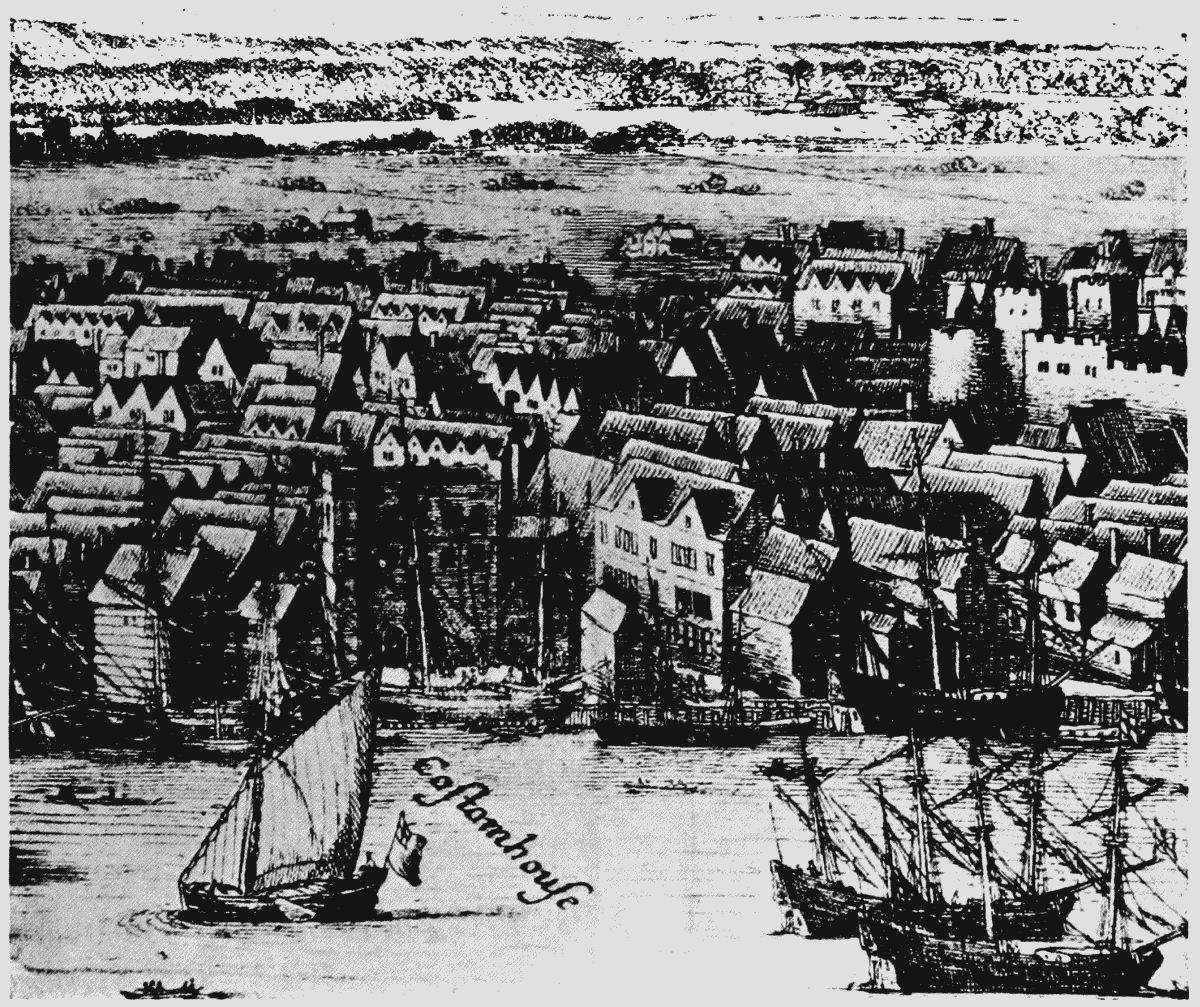
Custom House (Hollar)
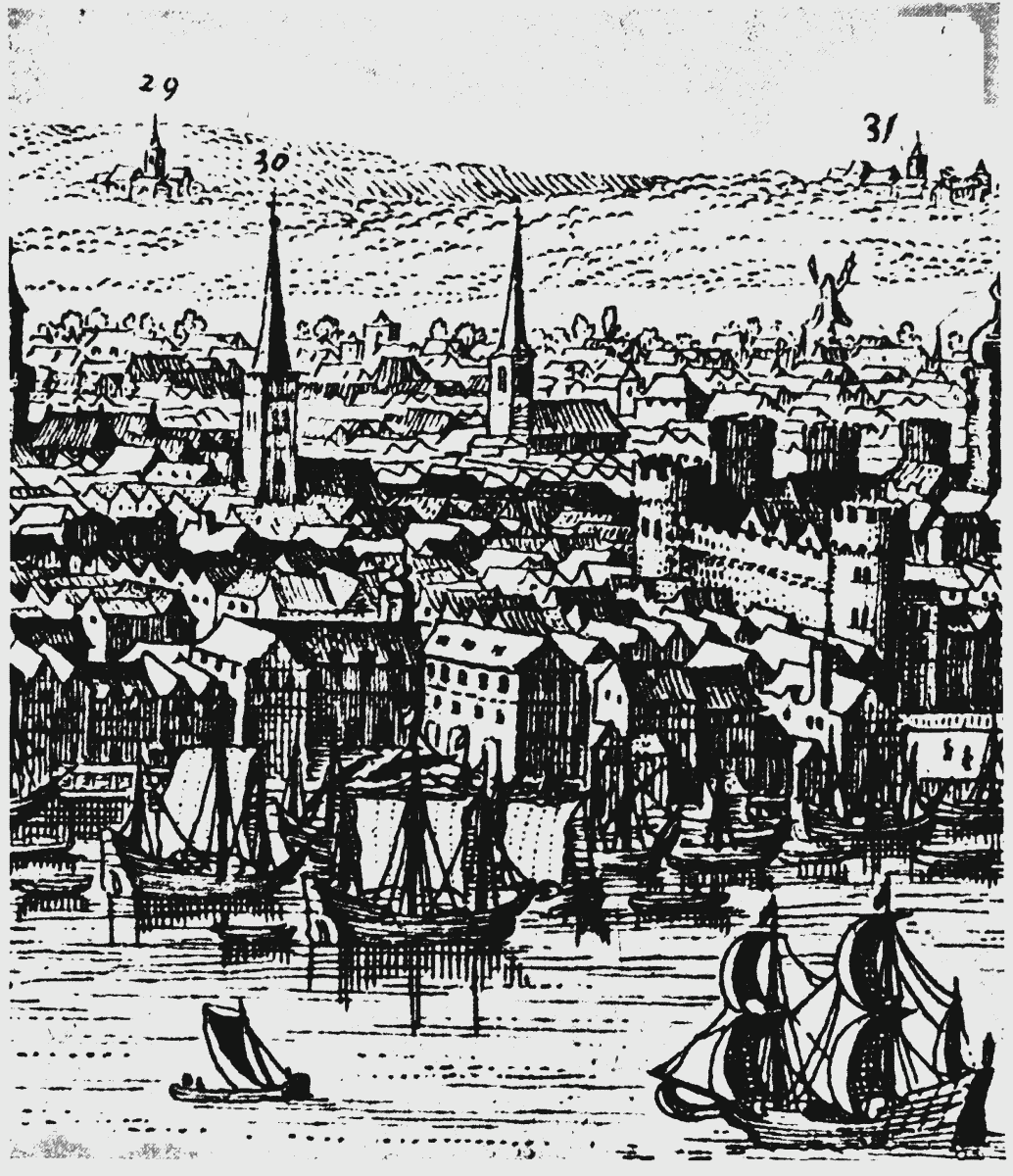
Custom House (Merian)
The Elizabethan Custom House sufficed both for the Farmers' and the Crown's officials for more than a hundred years, when it was completely burned out in the Fire of London. In the picture published by Bowles in the 18th century, from an earlier drawing of London as it appeared after the Fire, the whole of the building seems to have been reduced to a heap of ruins, with the exception of three of the towers before mentioned, which still stand.
The fire broke out on 2nd September, 1666, and on the 13th Charles issued his "Declaration to His City of London," in which he stated that he would use all expedition in rebuilding and enlarging the Custom House. (fn. 27) Unfortunately, difficulties arose. One immediate effect of the fire was to cause an unprecedented demand for builders, masons, carpenters and journeymen of all sorts, who put up their charges to a fantastic height. On the same day a warrant was issued by Lord Treasurer Southampton to the Customs Farmers, in which after referring to their representations that it was necessary that "the howse in Mark Lane, heretofore called by the name of Lord Baunis House, now appointed to be the Custom House, be with all speed brought into that forme as may answer that use, and that the late ruins of howses in the Citty of London by the late conflagration gives so much imployment to carpenters, bricklayers and masons that they cannot be procured but by some speciall warrant, this service being for the publique trade of the Citty and so consequently for the advantage of the whole body," he authorised them to "press as many men as they have present occasion of for this service, duly paying them their usual wages and discharging them as soon as they should have finished." (fn. 28)
In February of the following year a very explicit and elaborate direction was issued to the Farmers and to the Surveyor-General of Lands, the Surveyor of Works and other professional men, to make an elaborate survey of the ruins and also of the whole of the quays from the Tower to London Bridge, with a view to rebuilding the Custom House in suitable fashion either on the original site, or if it should be found more expedient, on any other site between those two boundaries. They were also to prepare "a draught or modell of a new Custom House." (fn. 29)
Two years passed without any further step, but on 26th January, 1668–9, the following letter appears in the Treasury Records:
"After our hearty commendations. Whereas the Modell for rebuilding His Majesty's Custom House is now agreed on, and the season draws on for preparing the ground and laying the foundations, We desire you to give order and take effectual care that all sheds and other buildings which are sett upon the said ground be pulled downe and the materials removed before the 14th of February next." (fn. 30)
The actual warrant for the rebuilding is dated 5th March, 1668–9. The site of the new building was considerably larger than that occupied by its predecessor. Additional land was taken for the extension from Sir Anthony Cope, but it is to be noted that the building did not, as did its successor, extend northwards to Thames Street. A considerable strip of land was left on the north side, which was later occupied by two rebuilt taverns and a large warehouse owned by Sir Anthony. The first cost was estimated at £6,000, "and inasmuch as the estimate … may be enhanced and out-run if it should be left at liberty for every officer to have what cost and conveniencies he thinks fit to be done, therefore We do order that no waynscott or other joyners' work be made or used but in the two public offices called the Great Custom House and the Searchers' Office, and there, not above ten foot high, and that the benches and tables round the Great Custom House do not exceed the dimensions of five foot breadth for the tables and a foot and a half for the benches, and be only covered with cloth in the same manner as in the old Custom House, and that there be no manner of workmanship or cost either there or in any other office bestowed, except in plain tables and benches, and those covered with cloth where the like were so in the old Custom House before the Fire, without any drawers, desks, boxes, presses, shelves, pertitionings of walls or other furniture of rooms, except at the proper cost and charge of the person for whose conveniency it's done." (fn. 31)
It very soon became apparent that the original estimate of £6,000 would be exceeded, and in May, Wren and various others met in consultation and it was left to the former to say what alterations were really essential. On 25th May the Treasury agreed to an extra £3,000, and a warrant was issued to commence building after "Mr. Wren's model." (fn. 32)
Building went steadily forward, various warrants being issued on the Customs for the payment of expenses until July, 1671, when the final one for £1,200 was issued to Philip Packer, Paymaster of Works, " for finishing the building of His Majesty's Custom House." (fn. 33)
The total cost of building was £10,252 6s. 8¼d. as shown in the Declared Accounts. (fn. 34)
The accounts are set out in the minutest detail and cover many pages. They are too long to quote, but there are many items of interest. The roofing cost £434 13s. and the three hundred feet of architrave cost £225 at 15s. a foot. One hundred and sixty-two lights for sixty-eight transome windows cost £65 6s. A gibbet in the warehouse to hang a beame [scale] cost £2 10s. The stone coat of arms cost £20. A black marble chimney-piece in the council chamber cost £8 10s. The King's Arms in the Long Room cost £1 6s. to set up, while two new large sundials in painted glass for the Commissioners' Room cost £8 10s. The whole of the window glass to the amount of 1,719 feet cost £42 19s. 6d.
Wren's Custom House was one of his most perfect buildings. Its proportions were delightful, and it was admirably suited for its purpose. Unfortunately it had a comparatively short life. In the Daily Courant of 15th January, 1714–5, we read the tragic story. "On Thursday evening a fire broke out in Thames Street not far from the Custom House, occasioned by the accidental blowing up of a house where gun-powder was sold which fired the two houses next to it. The wind at the same time blew very strong at South West which drove the flames with that violence that several other houses were soon on fire, and the rage of it consumed all that night with some intermission and till near noon yesterday, in which time there were consumed about seven houses on the South side of Thames Street and many warehouses down to Bear Key, about six houses on the North side the same street, all the West side of Water Lane up to Tower Street and therein the Trinity House, the back part of Bakers' Hall and some of the houses near it. The Custom House was preserved but a great quantity of Merchants' goods were destroyed in the warehouses or spoiled in the removal."
Unfortunately this account is hardly accurate. The Custom House was so badly damaged that it was found impossible to repair it, and it was entirely rebuilt.
The architect on this occasion was Thomas Ripley, who at the time was "Master-Carpenter" to the Board of Customs. The Office of Works indeed prepared plans, but they were rejected out of hand by the Board of Customs as being totally unsuited to the requirements of the Department.
The wars of William III and Anne had placed on the statute book so many new Customs Acts that the staff had grown enormously since the erection of the previous building, and it was determined to build on a still larger scale. For this purpose the land at the rear facing Thames Street was acquired from Sir Jonathan Cope. This included the "Rose and Dolphin" tavern, while the "Vine" tavern was also acquired. This enlargement of the area gave a straight frontage to Thames Street, but even this was insufficient, and it was determined to obtain further land on the east, as well as to build the new Custom House to three storeys instead of the two of Wren's building.
The new land on the east was that which in the year 1430 William Sevenoke, citizen and grocer, left by his will for the maintenance of Sevenoaks Grammar School. (fn. 35) Being a perpetual trust, it was necessary to procure a special Act of Parliament for the purchase. This Act (8 Geo. I, Cap. xxxi, 1721) in a very long preamble sets out the history of the quay, and concludes: "Be it enacted etc., That piece of ground called 'Harts-Horn Key' etc., vested in Trustees for the use of the Crown, chargeable with the payment of £2,500 with interest and the annual rent of £550 for the purposes in the Act, payable to the Wardens etc. of Sevenoaks, interest of the said sum to be computed after the rate of £4 Ios. per Ann, payable out of the Customs. The said £2,500 and interest to be paid to the Wardens etc. before March 25th, 1722, who are to expend the same in rebuilding … the school etc."
The main body of the new building on its river frontage followed the ground plan of Wren's building, and the measurements are so exact that it would seem to have been built on the same foundations, which were perhaps still sound after the fire. This fact gave the new building, in spite of its great interior differences, something of the same general appearance as Wren's Custom House, but the addition of the attic storey robbed it of the perfect proportion which had been a feature of its predecessor. The additional east wing was built in a completely different style, and so did not detract from the architecture of the main building, of which it had no appearance of being a part.
The cost, together with that of the newly acquired land, was very great. The cash payments for the ground were £3,000 to Sir Jonathan Cope and £2,500 to the school, while the former was also paid a rent of £420 per annum and the school £550 per annum. The estimate for the new building was £8,940, but, as is usual with estimates, it was heavily exceeded, the total cost of the building amounting to £11,086. Ripley was called upon to explain the excess and, to a certain extent, did so. He claimed that he had to make a new shore on which to build the new quay, a new crane house and various underground vaulting which had not been foreseen in the estimate, to the total amount of £1,707, but rather casually passes over the balance by saying " a great many more things done that could not be foreseen and too tedious to mention." (fn. 36)
Ripley's Custom House was designed to have a cupola, but for some reason this was not at first carried out, and there is an item in the accounts of £70 for making good the floor and roofs where the cupola was to stand. Fifty years later a very insignificant one was placed in position, and appears in the Pugin and Rowlandson print of 1805.
Ripley's Custom House served sufficiently well till the end of the eighteenth century, but with the growing trade, the opening of the docks and the vast increase in the Customs Duties in the period of the French wars, it had by that time become insufficient for the business of the revenue. Under the authority therefore of a special Act of Parliament (52 George III, Cap. 49) the Legal Quays to the west were purchased by the Crown for the express purpose of providing a site for a new building which should serve its purpose for many generations. The preamble of this Act states that the Custom House was then "inadequate, ruinous and dilapidated."
The first stone of the new building on a site immediately to the west of the old building was laid on 25th October, 1813, David Laing being the architect. Four months later, on 12th February, 1814, the Old Custom House was completely destroyed by fire. This broke out in the quarters of the housekeeper on the top floor, but, owing to the fear caused by the knowledge that gunpowder was stored in the basement, no adequate steps were taken to suppress the outbreak. It burned slowly down all through the night and throughout the next day, at the end of which the flames finally reached the small amount of powder in the quarters occupied by the Custom House Volunteers, and also the very considerable quantity of spirit stored in the King's Warehouse. The final explosion of this demolished the major part of the walls then standing, and scattered multitudes of customs papers far over the metropolis, so that later they were brought back from as far away as Hackney Marshes.
This was the end of the association of the old Wool Quay with the Customs Service, with the exception of a small office which was retained for the "Searchers" in the building which arose on the site. The quay is still known as Custom House Quay, and in legal documents also as Wool Quay, but it is now given over to the activities of a very up-to-date steamship company, and all association with wool has passed away.